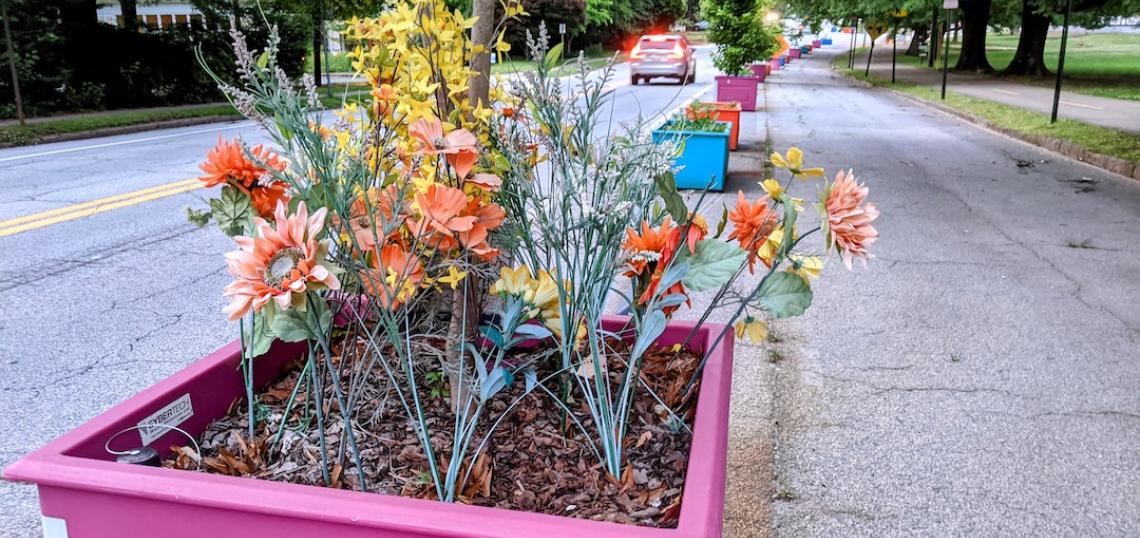Huckleberry Starnes, a product designer who lives in Oakhurst, has trouble turning off his creativity when not at work. The kind of guy who tools around a woodshop in his spare time.
It’s this penchant for making stuff that inadvertently earned Starnes a nickname, “The Planter Guy,” for a while. It still makes him cringe.
As Decatur’s de facto Planter Guy (apologies), Starnes knows everything about a can’t-miss row of roughly 200 plastic planters—all cheerful in primary colors—that lines West Howard Avenue, one of the busiest, most important arteries for entering or leaving the DeKalb County seat.
The street planters, as ordinary as they may sound, are both locally famous and infamous. They have fans and vocal enemies. They have factored into local elections, likened in 2019 to Decatur's equivalent of Hillary’s emails for commissioners who'd let them exist. They’ve made the news—a lot. In terms of WTF double-takes per linear yard, surely no other traffic-calming measure in metro Atlanta comes close.
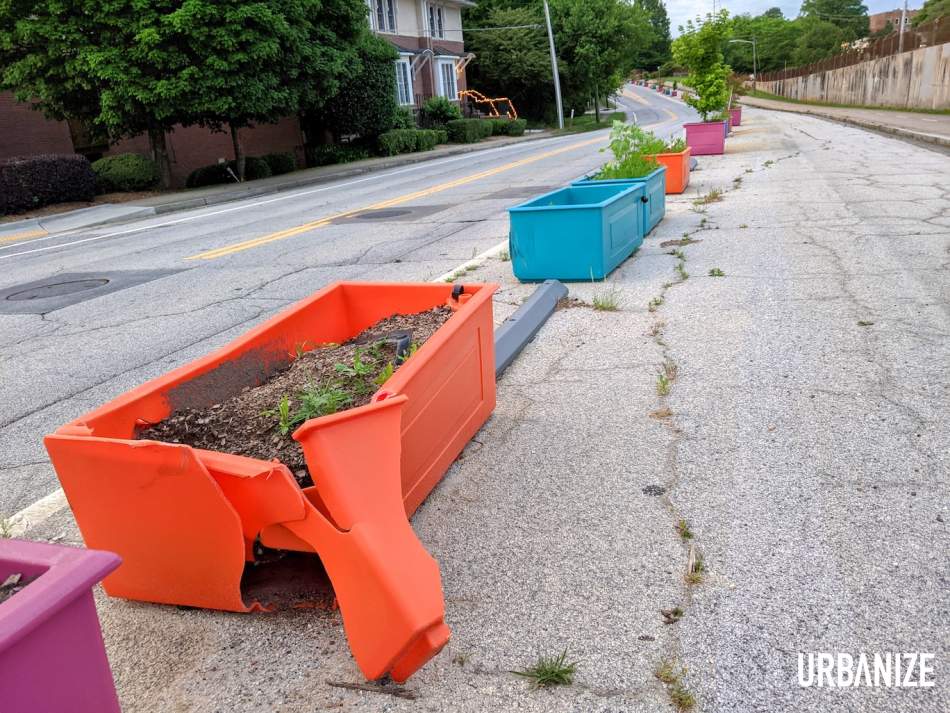 Planters have done a bang-up job keeping cars and pedestrians separated, per city officials. Photos by Josh Green/Urbanize Atlanta
Planters have done a bang-up job keeping cars and pedestrians separated, per city officials. Photos by Josh Green/Urbanize Atlanta
Maybe you’ve seen the city-issued, pandemic-era yard signs around Decatur that warn people: “Wear a Mask (or we’ll get more planters).” Starnes made those. He’s also created a line of products—coffee mugs, shirts, totes, koozies, ornaments, license plates—featuring a row of sad planter boxes, one of them oozing dirt, another holding what looks like Charlie Brown’s Christmas tree, only more pathetic.
Downtown boutique Sq/Ft Decatur carries a complete line of Decatur planters merchandise. Hundreds of cars in Atlanta are adorned with planter box magnets. Starnes says he’s breaking even on selling it all, a passion project befitting his sense of humor. He calls “Planter Guy” status an embarrassing side-effect.
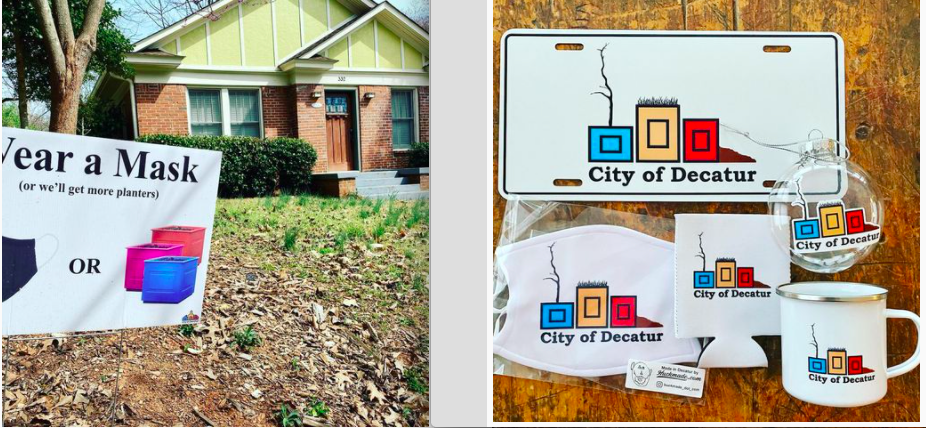 The planters as public service—and a sendup of the classic Decatur logo. Huckmade.com
The planters as public service—and a sendup of the classic Decatur logo. Huckmade.com
But after nearly three years of service (some might say disservice), the planter boxes’ days are numbered. Which raises an important question: When the planters are just orange, blue, and purple memories, who will have won?
“Whenever I’d post something [online] or see people around, I’d get an earful on both sides” of the great planter debate, says Starnes. “So I can tell you, based on hundreds if not thousands of conversations about those planters, how most people feel.”
Starnes says public sentiment boils down to three camps. City planning authorities agree with him, more or less. Let’s begin with the naysayers, the planter poo-pooers:
…
Camp One: “I don’t understand why these damn things are here”
Individually, the planters have what could be called grades, if not personalities.
There are pristine purple planters with thriving maples. Pretty planters with crepe myrtles and wildflowers. Planters busted by car collisions, like stepped-on, oversized Legos. Planters with dangling ornaments left over from the Holidays. Vibrant planters packed with fake flowers. Cube planters. Horse-trough planters. Sad planters full of little more than graying dirt. Planters, planters, planters in the street for miles! (Actually it’s one solid mile, stretching from East Lake MARTA Station to Decatur High School.)
Every bit of that—except for the broken parts—was by design.
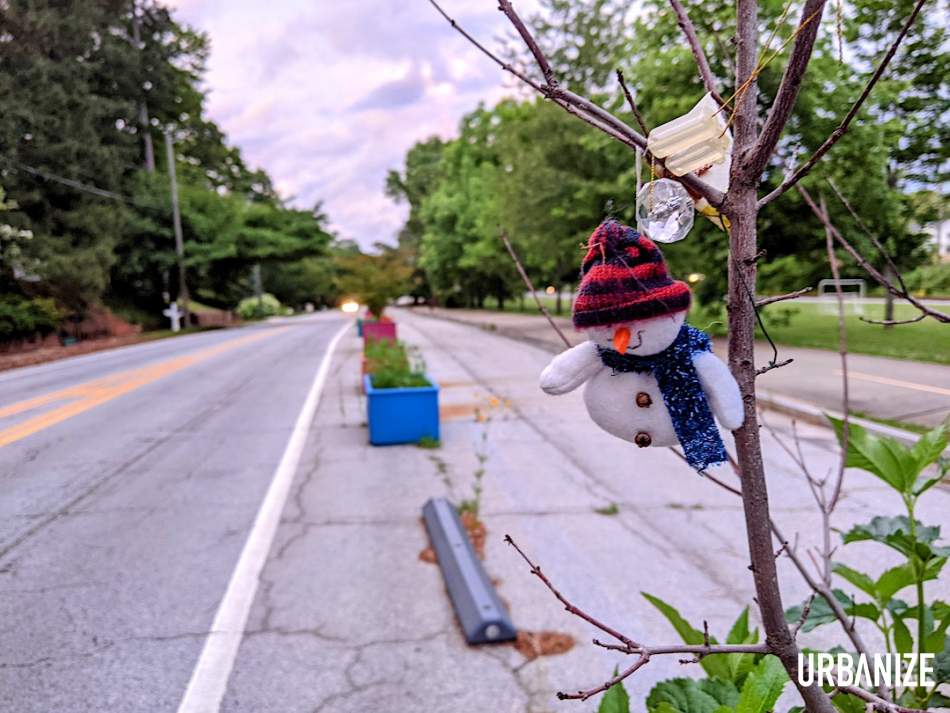 A planter adherent near Atlanta Avenue. Josh Green/Urbanize Atlanta
A planter adherent near Atlanta Avenue. Josh Green/Urbanize Atlanta
According to Decatur’s deputy city manager, Hugh Saxon, the city of 26,000 has made a push in recent years to beef up bike and pedestrian safety, installing five and ½ miles—and counting—of bicycle lanes and multiuse trails. The efforts are paying off; Decatur was recently named a “Gold Level Walk Friendly Community” by the Walk Friendly Communities Program, an organization that rates places on walkability.
“We’re easily the smallest city to achieve that rating,” Saxon notes, his pride almost palpable over the phone. “I think we’re now [considered] ‘Bronze Level Bike Friendly,’ too.”
But West Howard Avenue had long been a beast—a dangerous confluence of outdoor recreation and hurried car commuters. A PATH Foundation trail linking Atlanta to Stone Mountain runs along the south side of the road, mere feet from roaring vehicles.
Through a process called “Reimagine Howard Avenue” a few years ago, city officials learned that speeding on that four-lane street was a top community concern. They hired consultants from Alta Planning and Design, hosted several public meetings, and developed a plan to halve Howard Avenue to two lanes, enhance signal lights, and install midblock crosswalks in several locations. But instead of going all in with a concrete-buffered cycle track or permanent road diet, they opted for a cheaper, temporary solution that would test the safety theory: self-watering plastic planters and a few buckets of paint for restriping. The cost was $283,000, versus up to $4 million.
But it wouldn’t have been very Decatur of Decatur to make the planters a uniform, sensible color.
 Some drivers have complained that planters cause themselves to be run over. Josh Green/Urbanize Atlanta
Some drivers have complained that planters cause themselves to be run over. Josh Green/Urbanize Atlanta
The planter “mastermind,” according to The Planter Guy, was city manager David Junger. (He’s recovering from surgery and wasn’t available for an interview.) Junger, as Starnes tells it, remembers Decatur as the funky artistic community it was two decades ago, before it became the coveted, pricey “Best Place to Live in Georgia.”
…
Camp Two: “Yeah, I get it, but why are they so ugly?”
The planters’ bizarre color scheme, it turns out, is actually an homage, an ode. Or maybe a satire.
“The idea was to take the colors from the city logo and put the planters in as a cheap, cheeky, artistic expression, while having some greenspace, some pollinators, and putting that area on a road diet,” as Starnes, who has now worked extensively with the city, explains. “Most people don’t understand that, and they just say, ‘I’m in a hurry, I’m trying to get to Tucker, I want both lanes’—which is exactly why the planters are there.”
The lane reductions and boxed plants debuted in August 2018. Saxon chuckles in remembering the rollout, saying, “They were controversial—I’ll put it that way.” Some feedback was positive. One op-ed writer called them “a gift,” a godsend for improving safety for kids walking to area schools. But it was generally the consensus, even among supporters, the planters were ugly and weird. Many other reviews were scathing.
“I don’t know why they put them there,” one driver fumed to 11Alive. “Anybody can get their car messed up.” Within months, indeed, distracted drivers started blasting the planters, including one case that saw five in a row wiped out, with soil spewed everywhere and a car impaled, as Decaturish reported. “They are a damn disaster,” wrote one commenter on that website. Another: “The planters are just a nefarious plan … so Decatur can feel good about making auto travel in and through [the city] that much harder.” Another: “[They're] just flat-out poor planning” and a “parade of shit sticks.”
Starnes noticed the early banter, drew a mock logo with planters, and put it on the Oakhurst neighborhood page as a joke. “People started freaking out,” he says. “‘I need that T-shirt! I need that on a bumper sticker!’ So I fell into making that stuff.”
Just before the pandemic, Starnes approached the city about creating the Howard Avenue Botanical Society. Grant funding would help bring in established artists to transform designated planter sections, taking over plantings and doing vehicle-wrap-style artwork around planters, as rotating exhibits. COVID-19 put the kibosh on all of that, but the city did hire Starnes as a “smartass consultant,” in his words, to come up with planter signs that conveyed pandemic protocol in the city.
Looking back, Starnes believes Decatur’s only misstep was expediting the leafy obstacles—or what’s known in cycling circles as “road furniture”—and not gathering more community feedback beforehand, including from artists.
“[Critics] see traffic-calming things in other cities and say, ‘Why can’t we have those?’” says Starnes. “They’re not totally wrong. The planters are an acquired taste.”
...
Camp Three: “Mission accomplished (kind of)”
This camp is more nuanced. But its members generally adore planter weirdness and think the hullabaloo has been hilarious. They’re quick to point out how the drop in collisions between cars and cyclists on West Howard Avenue—particularly at a tricky Atlanta Avenue railroad crossing—is totally righteous.
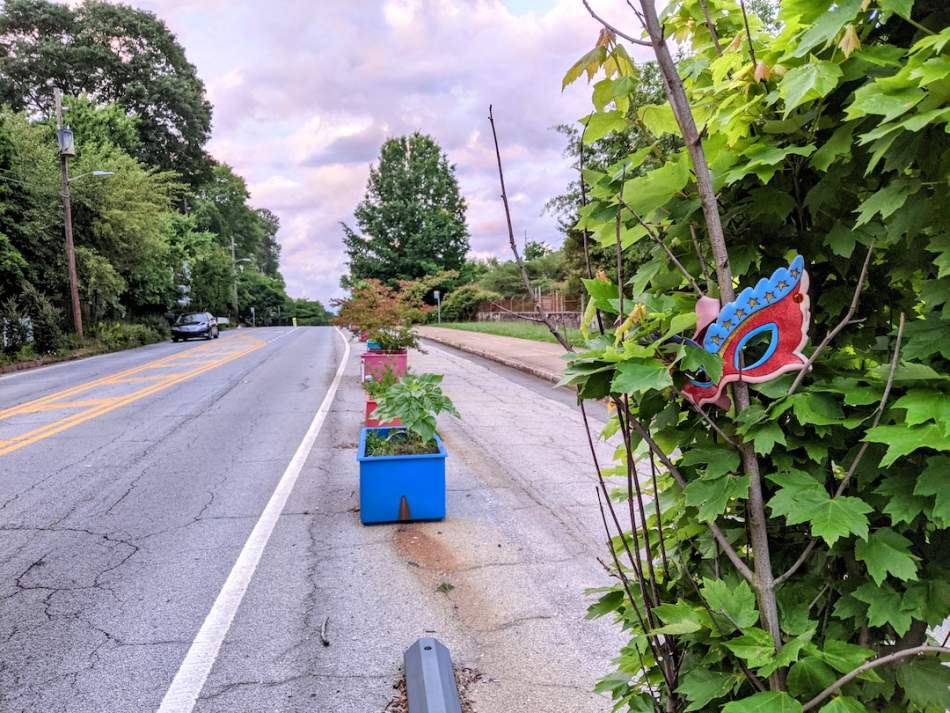 Many Decaturites never masked their planter disdain. Josh Green/Urbanize Atlanta
Many Decaturites never masked their planter disdain. Josh Green/Urbanize Atlanta
As bicycling has exploded during the pandemic, the “undesignated space” between the planters and PATH trail has become the domain of faster riders. Families have adopted trees—some of them now tall as basketball hoops—for decorating. Cars whack planters less frequently.
“It certainly validated the initial recommendations that [planters] would slow traffic and improve safety,” says Saxon. “I’m sure there’s a lot been written about them. But I think they’ve been effective. The plan worked.”
As part of a long-planned overhaul for the Atlanta Avenue railroad crossing, which is under review by CSX now, Decatur city officials are considering an SPLOST-funded reimagining of the whole West Howard Avenue corridor.
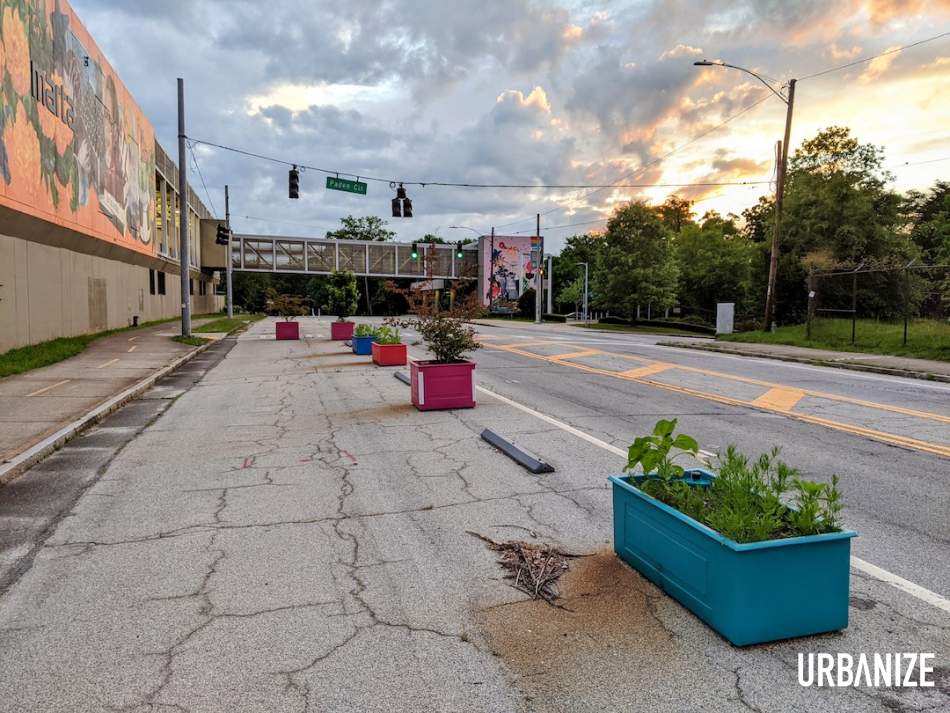 The controversial planters, come next year, could ride off into the sunset. Josh Green/Urbanize Atlanta
The controversial planters, come next year, could ride off into the sunset. Josh Green/Urbanize Atlanta
Possibilities include added parking on the road’s north side, and a cycle-track on the opposite side with raised islands and more permanent concrete planters, similar to what the Atlanta BeltLine has recently done in Glenwood Park. In which case the planters would go bye-bye.
Saxon says that work should be put out for bid in about a year. Costs won’t be known until estimates come back from contractors. The planters and plants would likely be donated.
“I think if we tried to remove them now, people would be up in arms,” says Saxon. “You never know how popular something is until you try to get rid of it.”




